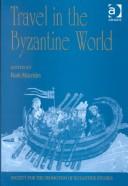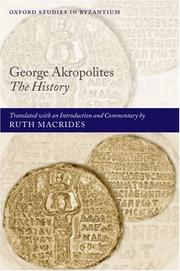| Listing 1 - 7 of 7 |
Sort by
|

ISBN: 0754607887 9780754607885 Year: 2002 Volume: 10 Publisher: Aldershot Ashgate
Abstract | Keywords | Export | Availability | Bookmark
 Loading...
Loading...Choose an application
- Reference Manager
- EndNote
- RefWorks (Direct export to RefWorks)
The contributions to this volume have been selected from the papers delivered at the 34th Spring Symposium of Byzantine Studies at Birmingham, in April 2000. Travellers to and in the Byzantine world have long been a subject of interest but travel and communications in the medieval period have more recently attracted scholarly attention. This book is the first to bring together these two lines of enquiry. Four aspects of travel in the Byzantine world, from the sixth to the fifteenth century, are examined here: technicalities of travel on land and sea, purposes of travel, foreign visitors' perceptions of Constantinople, and the representation of the travel experience in images and in written accounts. Sources used to illuminate these four aspects include descriptions of journeys, pilot books, bilingual word lists, shipwrecks, monastic documents, but as the opening paper shows the range of such sources can be far wider than generally supposed. The contributors highlight road and travel conditions for horses and humans, types of ships and speed of sea journeys, the nature of trade in the Mediterranean, the continuity of pilgrimage to the Holy Land, attitudes toward travel. Patterns of communication in the Mediterranean are revealed through distribution of ceramic finds, letter collections, and the spread of the plague. Together, these papers make a notable contribution to our understanding both of the evidence for travel, and of the realities and perceptions of communications in the Byzantine world. Travel in the Byzantine World is volume 10 in the series published by Ashgate/Variorum on behalf of the Society for the Promotion of Byzantine Studies.
Travel, Medieval --- Voyage --- Congresses --- Histoire --- Congrès --- Byzantine Empire --- Empire byzantin --- Civilization --- Congresses. --- Description and travel --- Civilisation --- Descriptions et voyages --- Travelers --- Travelers' writings --- History and criticism --- Conferences - Meetings --- Congrès --- Travellers --- Voyagers --- Wayfarers --- Persons --- Voyages and travels --- Byzantium (Empire) --- Vizantii︠a︡ --- Bajo Imperio --- Bizancjum --- Byzantinē Autokratoria --- Vyzantinon Kratos --- Vyzantinē Autokratoria --- Impero bizantino --- Bizantia --- Travel [Medieval ] --- Travelers - Byzantine Empire - Congresses --- Travelers' writings - History and criticism --- Byzantine Empire - Description and travel - Congresses

ISBN: 9780199210671 0199210675 Year: 2007 Publisher: Oxford Oxford university press
Abstract | Keywords | Export | Availability | Bookmark
 Loading...
Loading...Choose an application
- Reference Manager
- EndNote
- RefWorks (Direct export to RefWorks)
Latin Empire, 1204-1261 --- History. --- France --- Latin Orient --- History --- Latin Empire, 1204-1261 - History
Book
ISBN: 9780367601195 Year: 2020 Publisher: New York Routledge
Abstract | Keywords | Export | Availability | Bookmark
 Loading...
Loading...Choose an application
- Reference Manager
- EndNote
- RefWorks (Direct export to RefWorks)
The work known as Pseudo-Kodinos, the fourteenth-century text which is one of two surviving ceremonial books from the Byzantine empire, is presented here for the first time in English translation. With facing page Greek text and the first in-depth analysis in the form of commentary and individual studies on the hierarchy, the ceremonies, court attire, the Blachernai palace, lighting, music, gestures and postures, this volume makes an important new contribution to the study of the Byzantine court, and to the history and culture of Byzantium more broadly. The unique traits of this ceremony book include the combination of hierarchical lists of court officials with protocols of ceremonies; a detailed description of the clothing used at court, in particular, hats and staffs; an account of the functions of the court title holders, a description of the ceremonies of the year which take place both inside the palace and outside; the service of the megas domestikos in the army, protocols for the coronation of the emperor, the promotions of despot, sebastokrator and caesar, of the patriarch; a description of the mourning attire of the emperor; protocol for the reception of a foreign bride in Constantinople all these are analysed here. Developments in ceremonial since the tenth-century Book of Ceremonies are discussed, as is the space in which ceremonial was performed, along with a new interpretation of the ’other palace’, the Blachernai. The text reveals the anonymous authors’ interest in the past, in the origins of practices and items of clothing, but it is argued that Pseudo-Kodinos presents descriptions of actual practice at the Byzantine court, rather than prescriptions.
Middle Ages --- History --- History, Ancient --- Social aspects --- Classical studies.
Book
ISBN: 9781409412069 1409412067 9781315253305 9781351930635 9781138252387 1138252387 Year: 2010 Publisher: Surrey, England ; Burlington, VT : Ashgate,
Abstract | Keywords | Export | Availability | Bookmark
 Loading...
Loading...Choose an application
- Reference Manager
- EndNote
- RefWorks (Direct export to RefWorks)
Although perceived since the sixteenth century as the most impressive literary achievement of Byzantine culture, historical writing nevertheless remains little studied as literature. Historical texts are still read first and foremost for nuggets of information, as main sources for the reconstruction of the events of Byzantine history. Whatever can be called literary in these works has been considered as external and detachable from the facts. The 'classical tradition' inherited by Byzantine writers, the features that Byzantine authors imitated and absorbed, are regarded as standing in the way of understanding the true meaning of the text and, furthermore, of contaminating the reliability of the history. Chronicles, whose language and style are anything but classicizing, have been held in low esteem, for they are seen as providing a mere chronological exposition of events. This book presents a set of articles by an international cast of contributors, deriving from papers delivered at the 40th annual Spring Symposium of Byzantine Studies. They are concerned with historical and visual narratives that date from the sixth to the fourteenth century, and aim to show that literary analyses and the study of pictorial devices, far from being tangential to the study of historical texts, are preliminary to their further study, exposing the deeper structures and purposes of these texts.
Historiography --- Historiographie --- Byzantine literature --- History and criticism --- Byzantine Empire --- History --- Greek literature, Byzantine --- Greek literature, Medieval and late --- Greek literature --- Historical criticism --- Authorship --- Criticism --- Byzantium (Empire) --- Vizantii︠a︡ --- Bajo Imperio --- Bizancjum --- Byzantinē Autokratoria --- Vyzantinon Kratos --- Vyzantinē Autokratoria --- Impero bizantino --- Bizantia
Book
ISBN: 9780754667520 0754667529 9781315602790 9781317073949 Year: 2013 Volume: 15 Publisher: Farnham ; Burlington, VT Ashgate
Abstract | Keywords | Export | Availability | Bookmark
 Loading...
Loading...Choose an application
- Reference Manager
- EndNote
- RefWorks (Direct export to RefWorks)
Rites and ceremonies --- Byzantine Empire --- Court and courtiers --- Social life and customs --- Courts and courtiers. --- Hofcultuur. --- Manners and customs. --- Rites and ceremonies. --- Byzantine Empire. --- Istanbul. --- Rites et cérémonies --- Early works to 1800 --- Ouvrages avant 1800 --- Empire byzantin --- Cour et courtisans --- Moeurs et coutumes --- Early works to 1800. --- Rites and ceremonies - Byzantine Empire - Early works to 1800 --- Byzantine Empire - Court and courtiers - Early works to 1800 --- Byzantine Empire - Social life and customs - Early works to 1800
Book

ISBN: 3110331764 3110382288 9783110331769 9783110331776 3110331772 3110331632 9783110331639 Year: 2015 Publisher: Berlin Boston
Abstract | Keywords | Export | Availability | Bookmark
 Loading...
Loading...Choose an application
- Reference Manager
- EndNote
- RefWorks (Direct export to RefWorks)
Evolving from a patrician domus, the emperor's residence on the Palatine became the centre of the state administration. Elaborate ceremonial regulated access to the imperial family, creating a system of privilege which strengthened the centralised power. Constantine followed the same model in his new capital, under a Christian veneer. The divine attributes of the imperial office were refashioned, with the emperor as God's representative. The palace was an imitation of heaven.Following the loss of the empire in the West and the Near East, the Palace in Constantinople was preserved – subject to the transition from Late Antique to Mediaeval conditions – until the Fourth Crusade, attracting the attention of Visgothic, Lombard, Merovingian, Carolingian, Norman and Muslim rulers. Renaissance princes later drew inspiration for their residences directly from ancient ruins and Roman literature, but there was also contact with the Late Byzantine court. Finally, in the age of Absolutism the palace became again an instrument of power in vast centralised states, with renewed interest in Roman and Byzantine ceremonial.Spanning the broadest chronological and geographical limits of the Roman imperial tradition, from the Principate to the Ottoman empire, the papers in the volume treat various aspects of palace architecture, art and ceremonial.
Palaces. --- Emperors --- Symbolism in architecture. --- Architectural symbolism --- Signs and symbols in architecture --- Architecture --- Czars (Emperors) --- Rulers --- Sovereigns --- Tsars --- Tzars --- Kings and rulers --- Buildings --- Dwellings. --- Palace. --- palace architecture. --- places of power.
Digital

ISBN: 9783110331769 9783110382280 9783110331639 Year: 2015 Publisher: Berlin ;; Boston De Gruyter
Abstract | Keywords | Export | Availability | Bookmark
 Loading...
Loading...Choose an application
- Reference Manager
- EndNote
- RefWorks (Direct export to RefWorks)
| Listing 1 - 7 of 7 |
Sort by
|

 Search
Search Feedback
Feedback About UniCat
About UniCat  Help
Help News
News